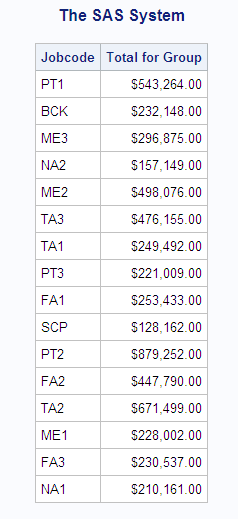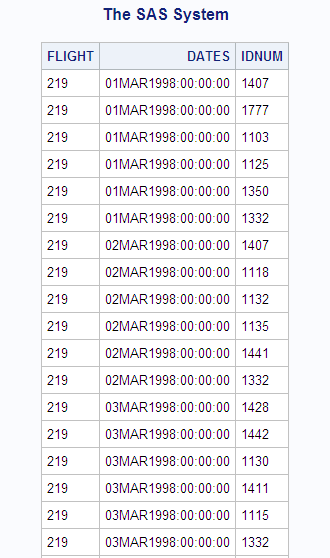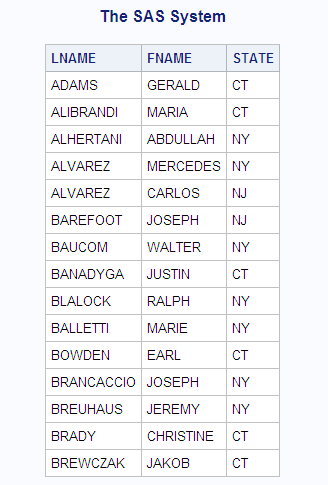Accessing a DBMS with SAS/ACCESS Software
Overview of Accessing a DBMS with SAS/ACCESS Software
SAS/ACCESS software for relational databases provides an interface
between SAS software and data in other vendors' database management
systems (DBMSs). SAS/ACCESS software provides dynamic access to DBMS data through the SAS/ACCESS LIBNAME statement and
the PROC SQL pass-through facility. The LIBNAME statement enables
you to assign SAS librefs to DBMS objects such as schemas and databases.
The pass-through facility enables you to interact with a DBMS by using
its SQL syntax without leaving your SAS session.
It is recommended that you use
the SAS/ACCESS LIBNAME statement
to access your DBMS data because it is usually the fastest and most
direct method of accessing DBMS data. The LIBNAME statement offers
the following advantages:
-
You do not need to know your DBMS's SQL language to access and manipulate your DBMS data. You can use SAS procedures, such as PROC SQL, or DATA step programming on any libref that references DBMS data. You can read, insert, update, delete, and append data, as well as create and drop DBMS tables by using normal SAS syntax.
An exception to this
recommendation occurs when you need to use SQL that does not conform
to the ANSI standard. The SAS/ACCESS LIBNAME statement accepts only ANSI standard for SQL, but the PROC
SQL pass-through facility accepts all the extensions to SQL that are
provided by your DBMS. Another advantage of this access method is
that pass-through facility statements enable the DBMS to optimize
queries when the queries have summary functions (such as AVG and COUNT),
GROUP BY clauses, or columns that were created by expressions (such
as the COMPUTED function).
Connecting to a DBMS by Using the LIBNAME Statement
Overview of Connecting to a DBMS by Using the LIBNAME Statement
Use the LIBNAME statement to read
from and write to a DBMS object as if it were a SAS data set. After
connecting to a DBMS table or view by using the LIBNAME statement,
you can use PROC SQL to interact with the DBMS data.
For many DBMSs, you
can directly access DBMS data by assigning a libref to the DBMS by
using the SAS/ACCESS LIBNAME
statement. Once you have associated a libref with the DBMS, you can
specify a DBMS table in a two-level SAS name and work with the table
like any SAS data set. You can also embed the LIBNAME statement in
a PROC SQL view. For more
information, see the CREATE VIEW Statement.
PROC SQL takes advantage
of the capabilities of a DBMS by passing it certain operations whenever
possible. For example, before implementing a join, PROC SQL checks
to determine whether the DBMS can perform the join. If it can, then
PROC SQL passes the join to the DBMS, which enhances performance by
reducing data movement and translation. If the DBMS cannot perform
the join, then PROC SQL processes the join. Using the SAS/ACCESS LIBNAME statement can often provide
you with the performance benefits of the SQL procedure pass-through
facility without writing DBMS-specific code.
Querying a DBMS Table
This example
uses PROC SQL to query the Oracle table PAYROLL. The PROC SQL query
retrieves all job codes and provides a total salary amount for each
job code.
Note: By default, Oracle does not
order the output results. To specify the order in which rows are displayed
in the output results, you must use the ORDER BY clause in the SELECT
statement.
Creating a PROC SQL View of a DBMS Table
PROC SQL views are stored query expressions that read
data values from their underlying files, which can include SAS/ACCESS views of DBMS data. While DATA
step views of DBMS data can be used only to read the data, PROC SQL
views of DBMS data can be used to update the underlying data if the
following conditions are met:
The following example
uses the LIBNAME statement to connect to an ORACLE database, create
a temporary PROC SQL view of the ORACLE table SCHEDULE, and print
the view by using the PRINT procedure. The LIBNAME engine optimizes
the processing of joins and WHERE clauses by passing these operations
directly to the DBMS to take advantage of DBMS indexing and processing
capabilities.
Connecting to a DBMS by Using the SQL Procedure Pass-Through Facility
What Is the Pass-Through Facility?
The SQL procedure pass-through facility enables you
to send DBMS-specific SQL statements directly to a DBMS for execution.
The pass-through facility uses a SAS/ACCESS interface engine to connect to the DBMS. Therefore,
you must have SAS/ACCESS
software installed for your DBMS.
You submit SQL statements
that are DBMS-specific. For example, you pass Transact-SQL statements
to a Sybase database. The pass-through facility's basic syntax is
the same for all the DBMSs. Only the statements that are used to connect
to the DBMS and the SQL statements are DBMS-specific.
You can use the pass-through
facility statements in a query, or you can store them in a PROC SQL
view. When a view is stored, any options that are specified in the
corresponding CONNECT statement are also stored. Thus, when the PROC
SQL view is used in a SAS program, SAS can automatically establish
the appropriate connection to the DBMS.
For more information,
see the CONNECT
statement, the DISCONNECT statement, the EXECUTE statement, and the
CONNECTION TO statement in SQL Macro Variables and System Options, and the
pass-through facility for relational databases in SAS/ACCESS for Relational Databases: Reference.
Note: SAS procedures that perform
multipass processing cannot operate on PROC SQL views that store pass-through
facility statements, because the pass-through facility does not allow
reopening of a table after the first record has been retrieved. To
work around this limitation, create a SAS data set from the view and
use the SAS data set as the input data set.
Return Codes
As you use PROC
SQL statements that are available in the pass-through facility, any
errors are written to the SAS log. The return codes and messages that
are generated by the pass-through facility are available to you through
the SQLXRC and SQLXMSG macro variables. Both macro variables are described
in Using the PROC SQL Automatic Macro Variables.
Pass-Through Example
In this example, SAS/ACCESS connects to an ORACLE
database by using the alias
ora2, selects
all rows in the STAFF table, and displays the first 15 rows of data
by using PROC SQL.
Updating PROC SQL and SAS/ACCESS Views
You can update PROC SQL and SAS/ACCESS views by using the INSERT, DELETE, and UPDATE statements,
under the following conditions:
-
If the view accesses a DBMS table, then you must have been granted the appropriate authorization by the external database management system (for example, DB2). You must have installed the SAS/ACCESS software for your DBMS. For more information about SAS/ACCESS views, see the SAS/ACCESS interface guide for your DBMS.
-
You can update a column in a view by using the column's alias, but you cannot update a derived column—that is, a column that is produced by an expression. In the following example, you can update the column SS, but not WeeklySalary:
create view EmployeeSalaries as select Employee, SSNumber as SS, Salary/52 as WeeklySalary from employees;
Note: Beginning with SAS 9, PROC
SQL views, the pass-through facility, and the SAS/ACCESS LIBNAME statement are the preferred
ways to access relational DBMS data. SAS/ACCESS views are no longer recommended. You can convert existing SAS/ACCESS views to PROC SQL views
by using the CV2VIEW procedure. For more information,
see Chapter 33, “CV2VIEW Procedure” in SAS/ACCESS for Relational Databases: Reference.
Copyright © SAS Institute Inc. All rights reserved.


